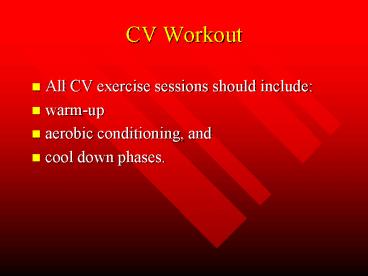CV Workout - PowerPoint PPT Presentation
1 / 19
Title:
CV Workout
Description:
CV Workout. A warm-up usually lasts 5 to 10 minutes. ... CV Workout ... and better suited for individuals initiating an aerobic exercise program. ... – PowerPoint PPT presentation
Number of Views:251
Avg rating:3.0/5.0
Title: CV Workout
1
CV Workout
- All CV exercise sessions should include
- warm-up
- aerobic conditioning, and
- cool down phases.
2
CV Workout
- The purpose of the warm-up is to
- increase blood flow to the working cardiac and
skeletal muscles, - increase body temperature,
- decrease the chance of muscle and joint injury,
- and lessen the chance of abnormal cardiac rhythms.
3
CV Workout
- A warm-up usually lasts 5 to 10 minutes.
- The longer you plan on exercising, the longer you
should warm-up.
4
CV Workout
- During the conditioning phase of the workout, the
aerobic exercise is performed according to the
exercise prescription.
5
CV Workout
- During cool-down, the individual continues
exercising at a low intensity for about 5 minutes.
6
Aerobic Training Methods
- Either continuous or discontinuous training
methods can improve CV endurance.
7
Aerobic Training Methods
- However, the dropout rate of adults in a
high-intensity interval training (discontinuous)
training program was twice that of those in a
continuous jogging program.
8
Aerobic Training Methods
- Generally, continuous exercise at low to moderate
intensities is safer, more comfortable, and
better suited for individuals initiating an
aerobic exercise program.
9
Aerobic Training Methods
- Potential forms of exercise include
- walking, jogging and cycling
- aerobic dance
- bench step aerobic
- step ergometry
- etc...
10
Aerobic Training Methods
- Discontinuous training involves a series of low
to high intensity exercise bouts interspersed
with rest or relief periods.
11
Aerobic Training Methods
- The exercise intensity and total amount of work
performed can be greater than that of continuous
training, making discontinuous training a
versatile method that is widely used by athletes
as well as by individuals with poor CV fitness.
12
Aerobic Training Methods
- In fact, the ACSM recommends the use of
discontinuous training for symptomatic
individuals who are able to tolerate only
low-intensity exercise for short periods of time
(3 to 5 minutes).
13
Aerobic Training Methods
- Interval training and circuit resistance training
are two types of intermittent or discontinuous
training.
14
Aerobic Training Methods
- Interval Training involves a repeated series of
exercise work bouts interspersed with rest or
relief periods.
15
Aerobic Training Methods
- Apply the overload principle by increasing the
exercise intensity or length of the work
interval, decreasing the length of the relief
interval, or increasing the number of work
intervals per exercise session.
16
Aerobic Training Methods
- Circuit resistance training for development of CV
fitness, as well as muscular strength and tone,
has received much attention.
17
Aerobic Training Methods
- Circuit resistance training usually consists of
several circuits of resistance training exercises
with a minimal amount of rest between the
exercise stations.
18
Aerobic Training Methods
- Because it produces only a 5 increase in aerobic
capacity as compared with a 15 to 25 increase
with other forms of aerobic training, it has been
concluded that circuit resistance training should
not be primarily used to develop aerobic fitness.
19
Aerobic Training Methods
- The aerobic exercise prescription should be
individualized to meet each clients training
goals and interests.































